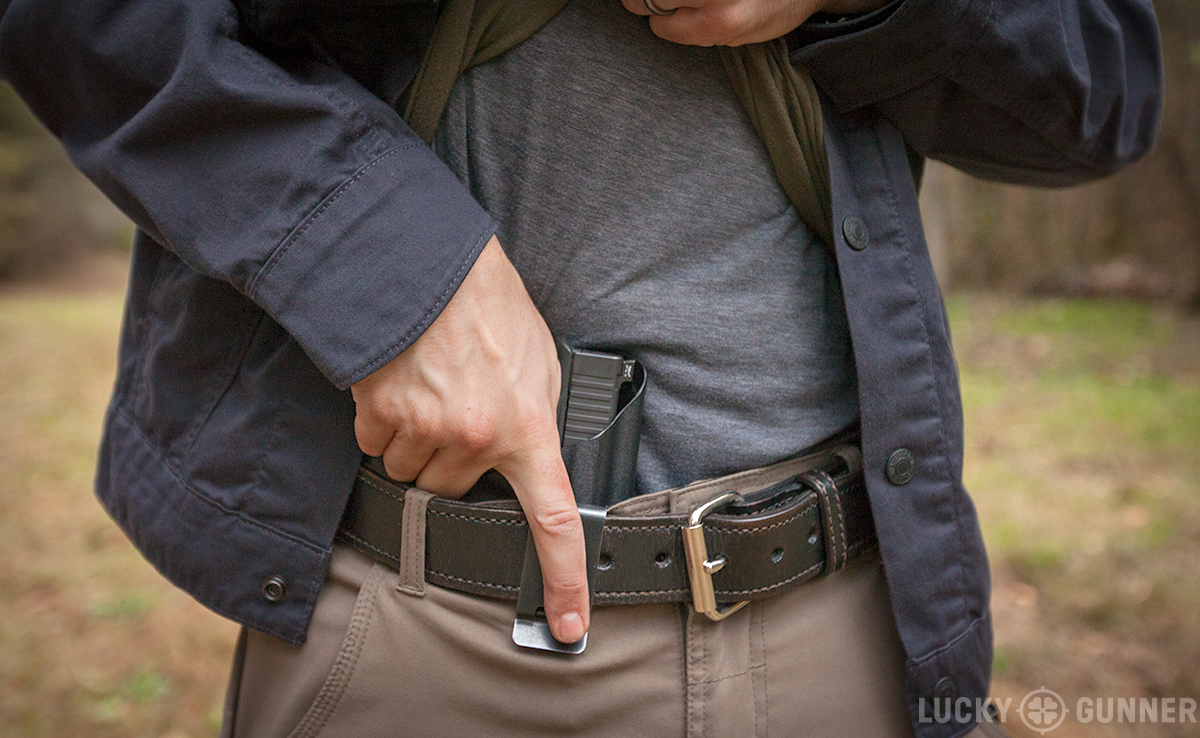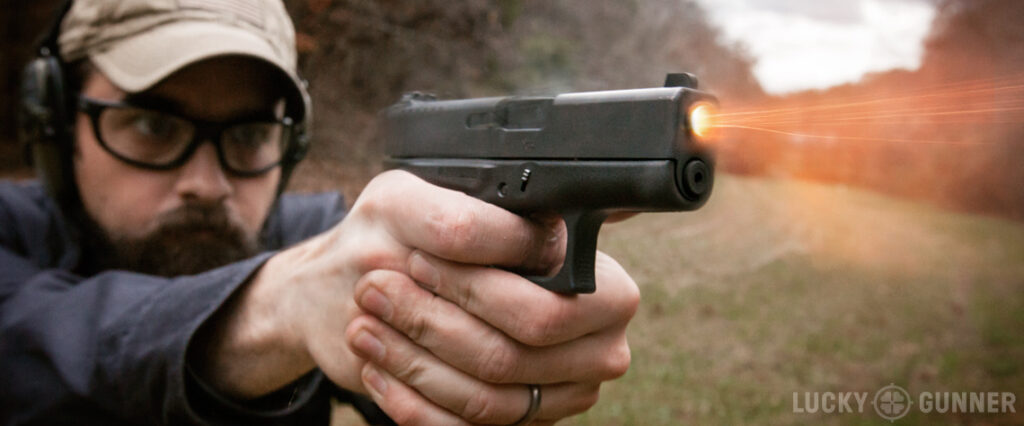There’s only one reason to carry a small gun like the Glock 43 instead of a larger and more effective pistol: convenience. We don’t carry small guns because they’re the best to have in a fight, but because they’re easier to conceal and more comfortable to carry around all day. The Glock 43 was designed with convenience in mind, but even so, is not a fashion accessory — it’s a tool made for fighting your way out of a life-threatening encounter.
Since I picked up a Glock 43 back in May, I’ve covered the run-of-the-mill technical specs and first impressions stuff, and even posted an update with more details. So far, I maintain my initial opinion that the G43 is an excellent option in the small, single stack 9mm category. It’s reliable and robust and it has well-designed ergonomics that mitigate the felt recoil and muzzle flip typically associated with pistols of this size. But now that I’m coming up on 3000 rounds through the G43, I wanted to give you guys something beyond the typical gun review-fodder and talk about a few aspects of the Glock 43 I’ve observed that relate more directly to its potential as a self-defense tool. In particular, I’ve noticed some quirks of the G43 that affect the bare essentials of self-defense shooting: getting the gun out of the holster, lining up the sights, and squeezing off multiple accurate hits to end the fight quickly.
Skin That Smoke Wagon
It’s been said, by myself and many others, that one of the most important skills you can develop with a firearm is the draw stroke. You can’t fight with a gun until it’s in your hands, so learning how to smoothly and quickly present the pistol from a holster is a critical component of self-defense. This can be challenging with the Glock 43. Small pistols that are valued for their low profile and ease of concealment naturally have less grip area to securely grab onto during the draw stroke. It’s very common for people to fumble the draw with these small guns, even during practice on a shooting range with no additional stress.
Besides consistent practice and good technique, the best way to mitigate these challenges is through careful holster selection. The first step of the draw stroke is to get a full firing grip on the gun with the dominant hand. Ideally, before you even start to remove the gun from the holster, you should have the same grip on it that you’ll have when it’s out at full extension and ready to fire. Whether you carry in a strong side belt holster or a 1 o’clock “appendix” holster, achieving a full firing grip is easy with a well designed holster, but a poorly designed holster can make it difficult, or even impossible.

The key features to look at are ride height and thumb clearance. Many holsters are designed with comfort and concealment as the primary considerations, with access being an afterthought. When the gun rides low, the grip may blend nicely into the belt line, but if there isn’t enough clearance for your fingers between the waistband and the front strap of the grip, it’ll be tough to get that full firing grip.
Thumb clearance is often hindered by a sweat guard — the raised part of the holster that provides a buffer between the body and the back of the slide. Todd Green posted a good example of this earlier this week. A sweat guard doesn’t necessarily have to be problematic, but if it prevents the web of the hand from getting as high up on the back strap as possible, a full firing grip can’t be achieved until the gun is partly lifted out of the holster.
I carry the Glock 43 in an appendix inside the waistband holster from Dark Star Gear. It has an adjustable ride height and a minimal sweat guard that keeps the rear sights from poking me in the gut but is strategically cut to allow a full firing grip. There are tons of holsters available for the Glock 43, but this is the kind of attention to detail you get when you buy a holster from someone who develops a design based on actual real world use and not comfort alone.
High Visibility
Besides the small grip, another quirk of the Glock 43 that could slow you down in a fight is the factory sights that come with the pistol. Like all other Glocks, the G43 ships with flimsy plastic sights that have a white dot painted on the front and a u-shaped white outline on the rear. Aside from their tendency to occasionally break off the slide with hard use, they really aren’t that much worse than the metal sights with three white dots that most other companies use as the default option, but that’s hardly a compliment.
Contrary to what Internet Experts might tell you, seeing the sights is an important component of fighting effectively with a handgun. It’s true that under the stress of an attack, many people panic and forget to bring the gun to eye level and line up the sights. Sometimes they manage to hit the target anyway, and sometimes they don’t. But we also have many first-hand reports of gun fight survivors who distinctly recall using their sights in the heat of the moment, and, believe it or not, these folks tend to end up with a hit percentage much higher than average. According to some research, among the factors that separate the “spray and pray” shooters from the sight users are regular practice and high visibility sights.
The major problem with the factory sights on the G43 is the lack of visibility. There’s no one-size-fits-all solution for pistol sights, but if you’re in immediate danger and have to draw that pistol, you probably want sights that are easy to see. I don’t have a strong preference for what’s on the rear sight, but I like to see an obnoxiously bright color on the front sight — something I can’t possibly miss. I’ve got Trijicon HD night sights on my Glock 43, with a bright orange ring on the front sight. There aren’t many lighting conditions in which night sights are actually all that helpful and I don’t consider them a “must-have” — the bright front sight and wide u-notch in the rear were the selling points for me. If you don’t mind the factory sights being plastic, a similar effect can be achieved by blacking out the rear sight with a marker, and some fluorescent orange paint or nail polish on the front sight. A fiber optic front sight is another high visibility and cheaper alternative to night sights. In any case, if you can only afford to make one modification to your Glock 43, I recommend upgrading the sights.
Trigger Warning
After improving the sights, many Glock 43 owners will be tempted to start tinkering with the trigger. Good trigger control is key for quick and accurate shooting, but even experienced shooters with solid fundamental skills will be slowed down by a lousy trigger.
There have been a variety of reactions to the quality of the trigger pull on the G43. This could be due to differing personal tastes or variations in manufacturing, but I suspect it’s some combination of both. The trigger on my Glock 43 weighs in at about eight pounds with the uneven “squishy” quality that all Glocks seem to have. No matter how you look at it, that’s a heavy trigger when the gun itself weighs only one pound.
But it’s not the G43’s trigger weight itself that bothers me. Regular readers of the Lounge might remember that 2015 has been the year of the revolver for me. I am no stranger to lightweight carry guns with triggers weighing 12 pounds or more. I won’t say I like that particular combination, but I have learned how to manage it fairly competently. However, even with that recent experience under my belt, the inconsistent feel of the trigger on the Glock 43 has proved to be a huge challenge for me when firing at the speed I run most other handguns, and I know I’m not alone.
The easiest solution is to take advantage of the many aftermarket trigger parts available like connectors and springs. These can slightly reduce the weight of the trigger pull and give it a smoother overall feel, leading to improved accuracy. Glock 43 trigger modifications are usually inexpensive and very simple to install, and most of them keep the weight of the trigger pull at a safe level. What’s not to like?
Well, unfortunately, sometimes improving the trigger can compromise reliability. The most common symptom is failure to fire caused by light primer strikes. The reliability of the G43 is one of its greatest strengths as a self-defense tool, but any change to the internals of the pistol has the potential to ruin that. I’m not saying you should never modify your carry pistol (although there’s a compelling case to be made for that position), but any changes should be followed by extensive test firing, both with standard FMJ ammo and with your chosen self-defense load.
You should also avoid making the trigger too light, even if reliability doesn’t suffer. Excessively light triggers can become a serious safety issue, and may also be a liability if you and your gun ever end up in court. Opinions vary on this point, but I personally wouldn’t want to carry a Glock with a trigger pull any lighter than 4.5 or 5 pounds.
Whether you modify your Glock 43 to your liking or leave it bone stock, put some serious thought into how you might have to use the gun as a life saving tool. You can try out different modifications to get the most out of it, but make these changes carefully and remember that no modification will affect your performance as much as dedicated practice. And if you choose not to change anything, keep in mind that a small pistol has inherent drawbacks in the usability department, and you might have to put in some extra range time to learn how to work around these challenges.

